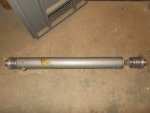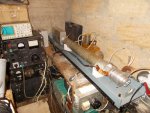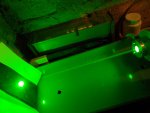- Joined
- Dec 4, 2016
- Messages
- 197
- Points
- 43
So, I have been away making a new fully homebuilt laser.
It is a manganese metal vapour laser. The laser tube is fully homebuilt. It is a self-heated tube. The main part of it is a ceramic bore tube with 14mm inner diameter and 60cm long. This tube is sorrounded with a layer of ceramic wool and then inserted in a wide quartz tube. At the ends of this tube there are electrode mounts machined from aluminium castings. Both anode and cathode are inox steel inserts. The electrode mounts are fixed on the quartz tube with flanges and fire-proof vacuum sealing gaskets. From the outside the quartz tube is sorrounded by another ceramic wool layer and outer aluminium tube, which serves as a backward conductor. Manganese metal is placed in two quartz vials inside the bore. Both mirrors are flat, the HR is aluminium coated, the OC is a flat quartz window. Both are attached to electrode mounts and faced inside the tube, so this is a tube with "internal" mirrors. Argon and helium are used as buffer gases. From the anode mount the gas is evacuated with a two stage rotary vacuum pump, from the cathode mount the gas is leaked inside the tube through a syringe needle. Gas pressure is monitored with a precise vacuum gauge. The laser is powered with my CVL power unit, which is homebuilt too. The laser tube draws 1.8-2 kW of input power to warm up, the pulse repetition rate is 10-12 kHz. The laser is started and warmed up with 20 Torr of Argon, than, when the bore is dark-orange hot, I shut off the Argon supply and let Helium inside. Optimal Helium pressure is 15 Torr. Quite soon the laser tube reaches its operating temperature, Mn metal starts to evaporate and lasing begins! The visible lasing line is 534 nm, very close to "common" 532 nm wavelength. Also there may be present some IR lines simultaneousely with the green one. I estimate the output power of my laser about 1 Watt at least, as it can burn wood and cardbord when focused. Some photos are attached, more can be seen here https://vk.com/album31425290_262758604










It is a manganese metal vapour laser. The laser tube is fully homebuilt. It is a self-heated tube. The main part of it is a ceramic bore tube with 14mm inner diameter and 60cm long. This tube is sorrounded with a layer of ceramic wool and then inserted in a wide quartz tube. At the ends of this tube there are electrode mounts machined from aluminium castings. Both anode and cathode are inox steel inserts. The electrode mounts are fixed on the quartz tube with flanges and fire-proof vacuum sealing gaskets. From the outside the quartz tube is sorrounded by another ceramic wool layer and outer aluminium tube, which serves as a backward conductor. Manganese metal is placed in two quartz vials inside the bore. Both mirrors are flat, the HR is aluminium coated, the OC is a flat quartz window. Both are attached to electrode mounts and faced inside the tube, so this is a tube with "internal" mirrors. Argon and helium are used as buffer gases. From the anode mount the gas is evacuated with a two stage rotary vacuum pump, from the cathode mount the gas is leaked inside the tube through a syringe needle. Gas pressure is monitored with a precise vacuum gauge. The laser is powered with my CVL power unit, which is homebuilt too. The laser tube draws 1.8-2 kW of input power to warm up, the pulse repetition rate is 10-12 kHz. The laser is started and warmed up with 20 Torr of Argon, than, when the bore is dark-orange hot, I shut off the Argon supply and let Helium inside. Optimal Helium pressure is 15 Torr. Quite soon the laser tube reaches its operating temperature, Mn metal starts to evaporate and lasing begins! The visible lasing line is 534 nm, very close to "common" 532 nm wavelength. Also there may be present some IR lines simultaneousely with the green one. I estimate the output power of my laser about 1 Watt at least, as it can burn wood and cardbord when focused. Some photos are attached, more can be seen here https://vk.com/album31425290_262758604
























